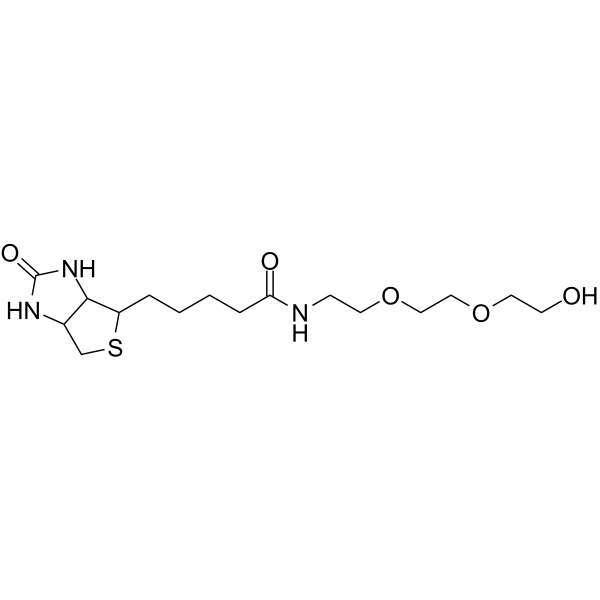
Biotin-PEG3-OH
CAS No. 1263044-40-1
Biotin-PEG3-OH( —— )
Catalog No. M26906 CAS No. 1263044-40-1
Biotin-PEG3-OH is a PEG-based PROTAC linker that can be used in the synthesis of PROTACs.
Purity : >98% (HPLC)
 COA
COA
 Datasheet
Datasheet
 HNMR
HNMR
 HPLC
HPLC
 MSDS
MSDS
 Handing Instructions
Handing Instructions
| Size | Price / USD | Stock | Quantity |
| 5MG | 37 | Get Quote |


|
| 10MG | 55 | Get Quote |


|
| 25MG | 87 | Get Quote |


|
| 50MG | 133 | Get Quote |


|
| 100MG | 201 | Get Quote |


|
| 200MG | Get Quote | Get Quote |


|
| 500MG | Get Quote | Get Quote |


|
| 1G | Get Quote | Get Quote |


|
Biological Information
-
Product NameBiotin-PEG3-OH
-
NoteResearch use only, not for human use.
-
Brief DescriptionBiotin-PEG3-OH is a PEG-based PROTAC linker that can be used in the synthesis of PROTACs.
-
DescriptionBiotin-PEG3-OH is a PEG-based PROTAC linker that can be used in the synthesis of PROTACs.(In Vitro):PROTACs contain two different ligands connected by a linker; one is a ligand for an E3 ubiquitin ligase and the other is for the target protein. PROTACs exploit the intracellular ubiquitin-proteasome system to selectively degrade target proteins.
-
In VitroPROTACs contain two different ligands connected by a linker; one is a ligand for an E3 ubiquitin ligase and the other is for the target protein. PROTACs exploit the intracellular ubiquitin-proteasome system to selectively degrade target proteins.
-
In Vivo——
-
Synonyms——
-
PathwayOthers
-
TargetOther Targets
-
Recptor——
-
Research Area——
-
Indication——
Chemical Information
-
CAS Number1263044-40-1
-
Formula Weight375.48
-
Molecular FormulaC16H29N3O5S
-
Purity>98% (HPLC)
-
SolubilityIn Vitro:?DMSO : 250 mg/mL (665.81 mM)
-
SMILESOCCOCCOCCNC(=O)CCCCC1SCC2NC(=O)NC12
-
Chemical Name——
Shipping & Storage Information
-
Storage(-20℃)
-
ShippingWith Ice Pack
-
Stability≥ 2 years
Reference
1. I Hilgert, et al. Antitumour and immunosuppressive activity of hydroxyanthraquinones and their glucosides. Folia Biol (Praha). 1977;23(2):99-109.
molnova catalog



related products
-
SARS-CoV-2 Mpro-IN-2
SARS-CoV-2 Mpro-IN-2 is a selective SARS-CoV-2M pro inhibitor with an IC50 value of 0.40 μM.SARS-CoV-2 Mpro-IN-2 has good antiviral activity and can be used to study COVID-19.
-
Collagen Binding Fra...
Collagen binding peptide is a conserved fibronectin peptide.
-
Benzododecinium chlo...
Benzyldimethyldodecylammonium chloride is a quaternary ammonium compound.Benzododecinium chloride is an irritant for eye.



 Cart
Cart
 sales@molnova.com
sales@molnova.com


